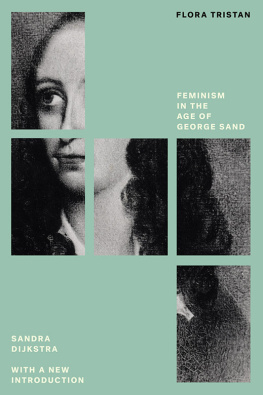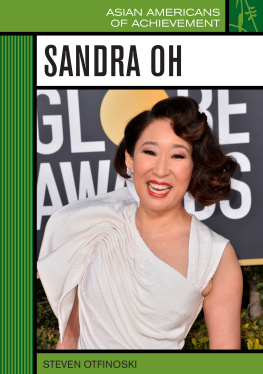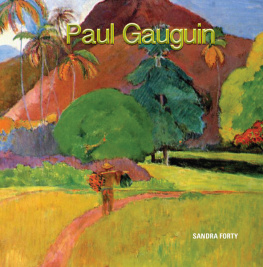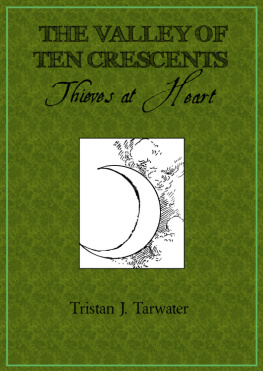Sandra Dijkstra - Flora Tristan
Here you can read online Sandra Dijkstra - Flora Tristan full text of the book (entire story) in english for free. Download pdf and epub, get meaning, cover and reviews about this ebook. year: 2019, publisher: Verso Books, genre: Science fiction. Description of the work, (preface) as well as reviews are available. Best literature library LitArk.com created for fans of good reading and offers a wide selection of genres:
Romance novel
Science fiction
Adventure
Detective
Science
History
Home and family
Prose
Art
Politics
Computer
Non-fiction
Religion
Business
Children
Humor
Choose a favorite category and find really read worthwhile books. Enjoy immersion in the world of imagination, feel the emotions of the characters or learn something new for yourself, make an fascinating discovery.
- Book:Flora Tristan
- Author:
- Publisher:Verso Books
- Genre:
- Year:2019
- Rating:5 / 5
- Favourites:Add to favourites
- Your mark:
- 100
- 1
- 2
- 3
- 4
- 5
Flora Tristan: summary, description and annotation
We offer to read an annotation, description, summary or preface (depends on what the author of the book "Flora Tristan" wrote himself). If you haven't found the necessary information about the book — write in the comments, we will try to find it.
Flora Tristan — read online for free the complete book (whole text) full work
Below is the text of the book, divided by pages. System saving the place of the last page read, allows you to conveniently read the book "Flora Tristan" online for free, without having to search again every time where you left off. Put a bookmark, and you can go to the page where you finished reading at any time.
Font size:
Interval:
Bookmark:


This paperback edition published by Verso 2019
Published by Pluto Press 1992
First published as Flora Tristan: Pioneer Feminist and Socialist,
Center for Socialist History, Berkley, 1984
Sandra Dijkstra 1984, 1992, 2019
All rights reserved
The moral rights of the author have been asserted
1 3 5 7 9 10 8 6 4 2
Verso
UK: 6 Meard Street, London W1F 0EG
US: 20 Jay Street, Suite 1010, Brooklyn, NY 11201
versobooks.com
Verso is the imprint of New Left Books
ISBN-13: 978-1-78873-486-8
ISBN-13: 978-1-78873-488-2 (UK EBK)
ISBN-13: 978-1-78873-487-5 (US EBK)
British Library Cataloguing in Publication Data
A catalogue record for this book is available from the British Library
The Library of Congress Has Cataloged the Hardback Edition As Follows:
Dijsktra, Sandra, 1942
Flora Tristan : feminism in the age of George Sand / Sandra Dijkstra.
p. cm.
Rec. ed. Of authors thesis (Ph. D.)University
of California, San Diego, 1976.
Includes bibliographical references and index.
ISBN 0-7453-0316-1
1. Tristan, Flora, 18031844. 2. FeministsFrance
Biography. 3. FeminismFranceHistory19th century. I. Title.
HQ1613.T75D55 1992 | |
305.420944092dc20 | 89-26663 |
CIP |
Printed and bound by CPI Group (UK) Ltd, Croydon, CR0 4YY
Thank you to Mike Davis, fighter for a better world,
for championing the publication of this new edition
To the first feminist in the family, and my
friend for life, Bram Dijkstra
And, of course, to the women, bold and brave, who have
inspired me, especially Inge Marcuse, Anita Schiller,
Naomi Alazraki, and the next generation, our nieces,
Petra Hasselbach, Claire Robinson, Fieke Neuman,
Michelle Sherman, and my sister, Barbara Hernandez
And, finally, to the amazing array of women
(and men) authors Ive had the honor of championing
In Search of a Literary Solution
Mphis ou le Roman dun Proltaire
The Discovery of a Mission
Promenades dans Londres
The Consolidation of a Project
Union Ouvrire and Le Tour de France
Flora Tristan began as a dissertation for the PhD Feminism in the Age of George Sand and has to be seen in the context of the womens movement of the early 1970s. It stimulated my interest in Flora Tristan as a subject. She was after all an astonishing woman, and despite my findings of the contradictions in the motives that mark her literary and political oeuvre, she made a very significant contribution to feminist and socialist thought and activity.
Giselle Pincetl generously offered to translate the numerous French passages. She has written on Flora Tristan from quite a different perspective and deserves praise for her good work, and for participating in a project whose thesis diverged so from her own. Gratitude is owed Sarah Lumpkin who undertook the arduous task of reviewing and checking footnotes of the revised manuscript.
Bram Dijkstra enthusiastically supported me and my intellectual pursuits, encouraged me at low points, and celebrated the high ones.
The woman who gave birth to me, ne Helen Rosen, deserves perhaps the greatest gratitude. Her constant and solid support of a project with which she had little sympathy, and of a daughter whose opinion frequently rankled her, is a testimony to her maternal and humane qualities. She, my grandmother Ida Rosen, my aunt Betty Feldman, and my sister Barbara Hernandez, provided me with encouragement and faith in woman power humanely used.
Adri Hasselbach provided invaluable assistance by copying Floras difficult script, thus making accessible to me Tristans letters housed at the Institute for Social History in Amsterdam.
Fredric Jameson, who as dissertation director presided over the early stages of this work, introduced me to new ways of looking at the nineteenth century and at literature.
Herbert Marcuses utopian vision and sense of humour offered me alternative futures and presents, and I only fear that he would find Flora taken much too seriously here though he would have undoubtedly adored her, had she been able to dance off the page.
All work is in some sense collective, a fragment of the spirit of an age. I only hope that I have imbibed some of its essence, and been able to transmit the vision of a better society which so inspired Flora Tristan.
August 1991
Del Mar, California
During the July Monarchy in France, the search to define the social categories of woman and of artist was intense and complex. With regard to the role of woman, two contradictory tendencies stand out: the attempt to delineate a concept of woman that would further consolidate and bolster the ascendant bourgeois social and economic order, and the attempt to create a nearly mythological new woman, through whose extraordinary qualities the injustices and inequities of that same bourgeois nexus might be broken.
Both tendencies took many forms. One of the bizarre features of the age was that the spectrum of duties assigned to woman as a force for integration and cohesion of the new capitalist power structure joined, at certain points, the role ascribed to woman as an agent of social change.
But this paradox was also central to the definition of the role of the artist during the 1830s and 1840s. Inspired (according to legend) by female muses, the artist seemed to confront alternatives similar to those offered to women of the time: should the artist serve private happiness or the public good? Somehow, these two impulses seemed to be increasingly irreconcilable, the first implying an acceptance of the new social order, and a consecration of its ideology, and the second allied to the forces for change.
Not surprisingly, women artists faced similar demands during this period from the diverse groups which sought to control the present and shape the future of France. The 1830s saw a crucial moment in the transfer of power to the class known as the grande bourgeoisie montante. Both groups offered redemption from materialism: in their ideal form they had no exchange value in the marketplace.
According to the Romantic conception promulgated by Fourier and the Saint Simonians, the artist exhibited his resistance to the new money system, and thus his superiority, through his poverty, his suffering and his exclusion; woman incarnated the mystique of a deity, a goddess whose extraordinary attributes were designed to lift her out of the murky marriage market and recuperate her lost splendour and status, at least on the level of the imagination.
This mythicization of the character and mission of women and artists was originally designed to accomplish too much: to imbue these groups with a sense of power and purpose, to recuperate for them the status they were losing as capitalist values and structures changed Frances ideological and industrial landscape, and to make them saviours of the new society. Thus, it failed miserably in all areas, and provided only a temporary illusion of attaining personal power and social change with women and artists in the vanguard.
During the July Monarchy, many artists and women succumbed to the temptation to view themselves through the filter of the new secularized religion that was Romanticism; they believed in the illusion of power it attributed to them, yet they were unable, despite all their attempts, to persuade a third group, the workers, to share in their deformation of reality. But their mythicization of the role of the working class certainly added fire to the very real and explosive content of the workers plight.
Font size:
Interval:
Bookmark:
Similar books «Flora Tristan»
Look at similar books to Flora Tristan. We have selected literature similar in name and meaning in the hope of providing readers with more options to find new, interesting, not yet read works.
Discussion, reviews of the book Flora Tristan and just readers' own opinions. Leave your comments, write what you think about the work, its meaning or the main characters. Specify what exactly you liked and what you didn't like, and why you think so.










